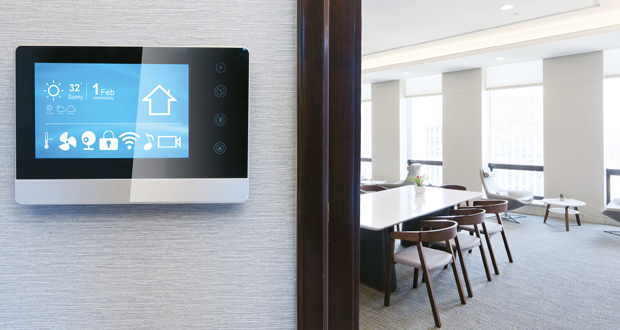What is the ideal office temperature in the UK and how does it compare to other less temperate regions of the world? Marina Vassilopoulos reports on behalf of PSG Global, an international provider of office-fit outs and relocation project management services
While the UK is known for its mild temperatures, averaging between 0ºc in the winter and 32ºc in the summer, global warming has begun to take its toll on the climate. On July 19th, 2022, a record temperature of 40.3ºc was recorded by the Met office. Many flocked to their workplace to take advantage of the air conditioning. Others have questioned if an increase in heat waves means it is time for the UK to introduce a maximum working temperature.
More recently, the Times reported that MPs have complained of overheating inside the poorly insulated Palace of Westminster, where some offices and meeting rooms are either freezing cold or unbearably hot. So, what is the new optimal temperature to set the thermostat to, especially as global warming escalates?
2022 SURVEY RESULTS
Several high-profile studies have discovered that the ideal office temperature usually falls between 21ºc and 22ºc. To answer whether or not this was still the case, we ran a survey, asking office workers across the UK what their ideal office temperature is – and whether they’d ever had an argument about the temperature in their workplace.
Of the 1,035 respondents, 286 (27.4 per cent) claimed that 21ºc was the temperature they preferred to work at. In close second and third, 247 (23.7 per cent) of respondents voted for 20ºc, while 224 individuals (21.5 per cent) preferred a 22ºc environment. While this change is subtle from the standard 21ºc to 22ºc environment, this alteration may suggest that as the UK grows warmer, air conditioning does not need to be as high – great news for firms, especially during the cost of living crisis.
However, demonstrating the need for temperature control, 572 (54.9 per cent) of respondents claimed to have had an argument about the temperature in their workplace. Why is this?
IMPACT OF TEMPERATURE ON WORKERS
The temperature of your office is a lot more important than you may initially believe. Temperature has a massive impact on your mood, and can have a subsequent impact on your productivity and attitude towards work.
A 2008 study conducted by Denissen et al. discovered that higher temperatures were associated with negative moods, leading to persons feeling irritable, distressed and jittery. Similarly, a 2013 study by Hsiang et al. discovered a link between higher temperatures and human aggression, with conflicts jumping by 14 per cent and interpersonal violence by four per cent in warmer environments. As a result, having your temperature set too high may directly lead to bad-tempered staff, sparking arguments.
 But it is not only hot weather that can have an adverse impact on mood. Cold weather can lead to several negative consequences, including insomnia, appetite changes, difficulty concentrating and even social withdrawal. All of these traits are symptoms of seasonal affective disorder (SAD), which regularly impacts one in three people during the winter months. As a result, your office temperature should not be high, nor too cold – making it difficult to decide the level at which you should set the thermostat.
But it is not only hot weather that can have an adverse impact on mood. Cold weather can lead to several negative consequences, including insomnia, appetite changes, difficulty concentrating and even social withdrawal. All of these traits are symptoms of seasonal affective disorder (SAD), which regularly impacts one in three people during the winter months. As a result, your office temperature should not be high, nor too cold – making it difficult to decide the level at which you should set the thermostat.
The ideal temperature is further complicated by the discovery that it is not only internal temperatures that can affect your staff. Sunshine, humidity and rain – factors the office thermostat sadly cannot control – can also alter your mood, with sunshine likely to increase your mood, while humidity and rain can make individuals more tired and irritable.
GENDER DIFFERENCES
Interestingly (and again complicating the ideal office temperature), scientists have noted that an individual’s gender has a profound impact on their preferred office temperature. An initial factor may have been the dress-code of a business, with men traditionally wearing suits in offices, while women wear skirts or dresses. Women would naturally be colder as a result of their clothing providing less coverage.
Despite this, findings by Tom Y. Chang, an Associate Professor at USC Marshall School of Business, conducted a study in which male and female students completed maths, verbal and cognitive tests – while wearing weather-appropriate clothing. These tests were completed at several temperatures, ranging from 61 (16.1ºc) to 91 (32.7ºc) degrees Fahrenheit.
The results discovered that women performed better at temperatures ranging from 70 (21.1ºc) to 80 (26.6ºc) degrees Fahrenheit, and that men performed better at below 70 degrees Fahrenheit. Concurrently, his team discovered that women were more negatively impacted by colder temperatures than men were by warmer ones. The study suggests that women are more susceptible to changes in temperature, regardless of the clothing worn.
As a result, it may be worth considering gender when setting your thermostat standard. A female-centric office may benefit from a warmer temperature, while a male-orientated office may prefer cooler climates.





